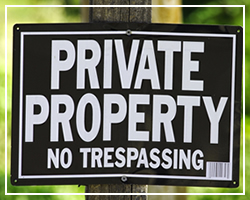Section 2. The Basics of Securing your Premises
| Site: | Extension Foundation Online Campus |
| Course: | Farm Security |
| Book: | Section 2. The Basics of Securing your Premises |
| Printed by: | Guest user |
| Date: | Sunday, December 14, 2025, 3:15 AM |
Description
The basics of securing your premises
The Three Ds of Farm Security
 Securing your premises doesn't have to be complicated. Determine and implement basic actions, and add more protections when necessary. An effective physical security system for your premises
Securing your premises doesn't have to be complicated. Determine and implement basic actions, and add more protections when necessary. An effective physical security system for your premises
Well-hidden permanently installed mailbox is based on the following three basic principles:
Deterrence
Detection
Delay
Be sure that your sound is on and your volume is turned up in order to properly view the presentation in the next section
The Three Ds of Farm Security Video
|
Problems viewing this presentation? Click here to update your Adobe Flash Player. |
Locking Your Facilities
Keep important areas such as your pesticide storage area locked.  Implement a system for checking facilities at the end of the day to ensure they are secured. Implement a system for checking facilities at the end of the day to ensure they are secured.
Cable ties do not provide protection. They only provide an indication that the lock has been opened. Seals are effective only if there is a system in place to check and verify seal numbers. An example is the metal clip electric power companies use on meters. |
Applying Key Control
|
Locks are effective if you keep track of the keys.
|
Using Signs to Deter
| Post and maintain “No Trespassing” signs along farm roads and property lines. Too often, signs are posted and forgotten, so they deteriorate, fall down, or get knocked down by vandals. As you do routine maintenance, remember to check your signs and replace when needed. Although signs will not keep out criminals, they will deter those who are simply unaware that they have entered private property. However, signs announcing the presence of alarms, detectors, or surveillance devices may be helpful in deterring crime. Signs warning of hazards may be important in limiting your liability. “Do Not Enter” signs for hazardous materials and hazardous areas such as manure pits, animal areas, hazardous materials storage, should be posted in languages understood by all employees and visitors, or as pictograms. |
Maintaining Clear Zones
Eliminate vegetation to maintain clear zones along fences,  roads, roads,around structures and especially along property lines. A distance of 15 feet is recommended. Remove all obstructions and places of concealment near your facilities. Do not use vegetation to conceal unsightly areas. It does not really hide anything and may only provide cover for intruders. For example, if shrubs are used to conceal an old well, the effect is purely cosmetic. Proper measures should be taken to lock or seal off the well.
|
